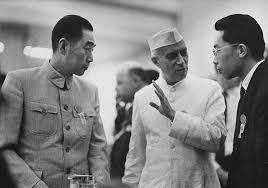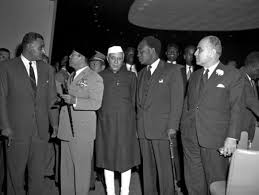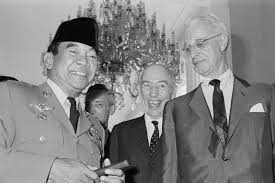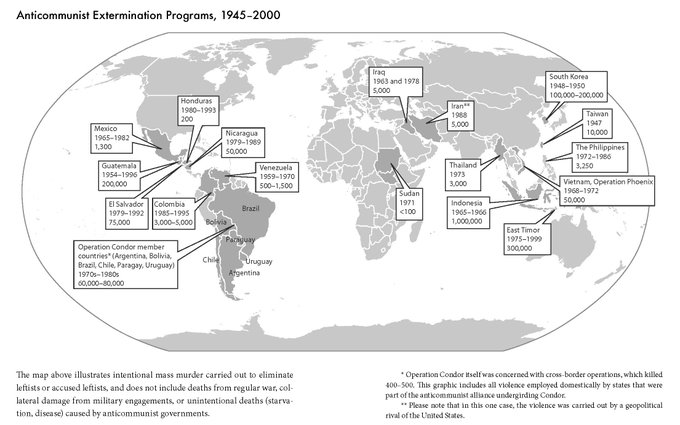US Anticommunist Extermination Programs 1945-2000
Tuesday, September 1st, 2020The Jakarta Method, Washington’s Anticommunist Crusade & the Mass Murder Program that Shaped Our World, Vincent Bevins, 2020
Zhou Enlai Nehru Nasser Sukarno Nehru
Nasser Sukarno Nehru 
In 1955 President Sukarno of Indonesia organized a conference of the leaders of the non aligned third world nations (former colonies) held in Bandung Java Indonesia. The conference was attended by representatives of 29 former colonial nations. Notable attendees in addition to Sukarno were Jawaharlal Nehru of India, Gamal Abdel Nasser of Egypt, and Zhou Enlai of China. The core principles of the Bandung Conference were political self-determination, mutual respect for sovereignty, non-aggression, non-interference in internal affairs, and equality. US Secretary of State John Foster Dulles (older brother of Allen Dulles) was strongly opposed to the conference. The Bandung conference represented the high point of the attempt to forge cooperation among non aligned third world nations.
This book features two contrasting Americans, Frank Wisner who worked for Allen Dulles in the WWII OSS and after at the CIA as Dulles’ master of covert (black ops) operations until Wisner killed himself in 1965; and Howard P. Jones, who served as US Ambassador to Indonesia from 1958 to 1964 and as Chancellor of the East West Center University of Hawaii from 1965 to 1968. President Truman wanted the CIA to serve as intelligence gatherers only, so Allen Dulles maneuvered Frank Wisner into position as OPC Chief and by 1952 OPC was operating 47 overseas stations operating out of US embassys and consulates and employed 3000 people. Wisner is the mastermind behind the early 1953 Iran coup (executed by Kermit Roosevelt) and the Guatemala coup of 1954 and every black ops through the 1964 Brazilian coup and the 1965 Indonesian coup.
Unlike Wisner, who was a die hard crusader, Jones had a completely different approach to the rest of the world. Rather than viewing every situation in terms of a black and white global struggle, he sought to engage deeply with the complexities of each situation.
Jones played an important role in repairing the damaged caused to United States-Indonesian relations by the Eisenhower Administration’s covert support for the failed PRRI/Permesta regional uprisings in Sumatra and the Celebes. Following the capture of an American pilot Allen Lawrence Pope (in 1958) who was participating in a Central Intelligence Agency (CIA) black op in support of the Permesta rebels, Jones portrayed Pope as an American “paid soldier of fortune” and expressed his regret at the involvement of an American.
JFK traveled widely after WWII, visiting Indonesia twice. When JFK became President he told Jones that Jones was solely in charge of relations with Sukarno and Indonesia. Reeling from the Bay of Pigs disaster, JFK no longer trusted the CIA and wanted Jones to have a hand free of interference from CIA black ops. After JFK’s assassination, LBJ, with almost no international experience but listening to JFK’s holdover advisors, stopped all cooperation with Sukarno and recalled Ambassador Jones. The CIA now had a free hand to move forward with overthrowing the Sukarno government and attacking the PKI communist party of Indonesia, at the time the third largest communist political party behind China and the Soviet Union. The coup began on Sept. 30, 1965 and on October 2, an unknown (except to key US policy makers) army general Suharto took over the government. On Oct 5, Ambassador Howard Green cabled the State Department:
Spread the story of PKI’s guilt, treachery and brutality (this priority effort is perhaps most needed immediate assistance we can giver army if we can find way to do it without identifying it as solely or largely US effort). .. The army now has the opportunity to move against Communist Party if it moves quickly…”It’s now or never.”
On Oct 29 Frank Wisner killed himself.
On Nov 22, D.N. Aidit, leader to PKI in Central Java was arrested and executed. The military reported and Newsweek published Aidit’s confession that the PKI planned to take over the country. His confession was impossible and a part of an anticommunist black propaganda operation.
In Jan. 1966, Bobby Kennedy was the only American politician to speak up:
We have spoken out against the inhuman slaughters perpetrated by the Nazis and the Communists. But will we speak out also against the inhuman slaughter in Indonesia, where over 100,000 alleged Communists have not been perpetrators but victims
What followed was a state sponsored massacre and genocide of a million Indonesians, many ethnic Chinese. These events are largely unknown in the US although a 2012 documentary The Act of Killing and a companion 2014 documentary The Look of Silence raised awareness for some Americans and others around the world. Indonesia is the only country that engaged in genocide and never attempted an accounting or reconciliation.
…in the years 1945-1990, a loose network of US-backed anticommunist extermination programs emerged around the world, and they carried out mass murder in at least twenty-two countries. there was no central plan, no master control room where the whole thing was orchestrated, but I think that the extermination programs in Argentina, Bolivia, Brazil, Chile, Columbia, East Timor, El Salvador, Guatemala, Honduras, Indonesia, Iraq, Mexico, Nicaragua, Paraguay, the Philippines, South Korea, Sudan, Taiwan, Thailand, Uruguay, Venezuela, and Vietnam should be seen as interconnected and a crucial part of the US victory in the Cold War… The men carrying out purposeful executions of dissidents and unarmed civilians learned from one another. Sometimes they even named their operations after other programs they sought to emulate. I found evidence indirectly linking the metaphor “jakarta”, taken from the largest and most important of these programs, to at least eleven countries. But even the regimes that were never influenced by that specific language would have been able to see, very clearly, what the Indonesian military had done and the success and prestige it enjoyed in the West afterwards.
Following are the conclusions of Harvard historian Odd Arne Westad:
We can see the Cold War as the global circumstances under which the vast majority of the world’s countries moved from direct colonial rule to something else, to a new place in a new global system. If we view it this way, then there is not a simple winner/loser binary between the United States and the Soviet Union. In the third world, there were many paths each country could take; more importantly, most of them are still on the specific path that was shaped and taken during the Cold War
The primary subject of this book is the CIA led mass murder programs designed to eliminate communist and any left leaning populations, but Bevins does spend some attention on the enormous economic pressures the US is able to exert on any government it is trying to undermine. The combination of trade policy, withholding of capital investment and International Monetary Fund (IMF) Neo-Liberal lending can bring any third world economy to its knees without any resort to CIA inspired mass murder programs. Neo-Liberal policies first found their experimental base in the 1972-3 Chili coup when several Chili native Chicago School graduates took charge of Chili’s economy under Pinochet and invited their professor Milt Friedman to advice them. Since that time, Neo-Liberal Chicago School economics have dominated most of the first world approach to the third world and Southern Europe and Ireland.
This book is very personal to this reader. In June 1965, I arrived as a graduate student grantee at the East West Center to work on a masters degree in International Relations with a goal of becoming a State Department diplomat. Chancellor (Ambassador) Howard Jones arrived at the East-West Center a month later.
Under the grant, students from the US and Asia study at the University of Hawaii for one year and then are granted a one year field trip in Asia or America. I passed the foreign service exam in Hawaii and was scheduled for an oral interview in Karachi Pakistan. There were a number of students from Indonesia at the Center and we all socialized so I was somewhat aware of events in Indonesia as they unfolded.
Hotel Indonesia Kempinski built by Sukarno in 1962 

When I left Hawaii, I had heard that as many as a half million Indonesians, many of them of Chinese ancestry had been killed. Sometime in late 1966, I arrived in Jakarta for a couple of week visit. I was met by an American from the Embassy who claimed to be there by chance. I am sure he was sent specifically to escort me. He insisted I was required to stay at the Intercontinental Hotel (five star, now Hotel Indonesia Kempinski) and was required to arrange any travel through the official travel agency located in the hotel’s arcade. The nightly room cost alone put a huge dent in my monthly travel stipend. Then I got lucky. The young Indonesian woman at the travel agency, realizing I knew Indonesian students studying in Hawaii arranged a great itinerary; by bus and train to Bandung, then on to Yogyakarta (the old pre-colonial capital). During the train trip to Yogyakarta, I met a young, Dutch trained military officer who was on his way to his wedding. He invited me meet his beautiful fiancee and to the reception, an Indonesian feast. From there I traveled by bus to the coast where I boarded a WWII landing craft to cross to Bali. All hotels were Dutch colonial era with ceiling fans. In Bali, plans were underway for a massive tourist buildup with an enlarged airport and numerous beachfront hotels. Outrigger canoes were arriving from Hawaii and Hawaiians were busily training Balinese for the expected tourists. There were nightly gamelan tourist performances in Denpasar but if I walked away from town guided by the gongs, I could find natural events in the nearby villages. I met an engineer living in a beachfront cottage who was working on the airport expansion. I then flew back to Jakarta where I explored for a few more days. At no point did anyone mention the killings. Bevins says that one of the Bali tourist hotels is called Ku De Ta, which he thinks may be Indonesian humor. It is possible this hotel and others have been built on mass beach front burial grounds. Bali experienced the highest level of killings per capita anywhere in Indonesia.
I met other US diplomats on my travels and quickly concluded that the State Department was not for me. One of my professors in Hawaii was a Bengal Communist who introduced me to several Indian Communist Labor leaders. I met one in Delhi who told me about a labor demonstration scheduled for that day. I got a bicycle rickshaw and dropped by the demonstration on my way to an evening party at the US Embassy. The demonstration was met by armed police who opened fire and killed a number of demonstrators. That evening I asked a reporter from Time Magazine and several diplomats about the demonstration and the killings and no-one had heard anything. A month later, while I was in Calcutta, a Communist labor leader told me about an upcoming general strike. A few days later, Calcutta was completely shut down by a massive, coordinated labor strike. In the 1967 general election the Communist Party won a majority in the state of Kerala. India somehow was spared the “jakarta” mass extermination experience. I later met diplomats and their wives in Katmandu who were all miserable and disappointed with their career paths. I never showed up for my Karachi interview and have never regretted that decision.

